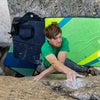Heading out the door? Read this article on the new Outside+ app available now on iOS devices for members! Download the app.
Our Thoughts
Apparently Scarpa’s new Veloce L is designed for beginner and intermediate climbers who spend all of their time at the gym—and for more advanced climbers who want something comfortable enough for a four-hour board session…
I didn’t get the memo.
Four months ago, after just two or three days of indoor bouldering (during which I marveled at the Veloce L’s comfort, sensitivity, and freakishly grippy S72 rubber), I brought them outside. Since then, they’ve been my go-to shoes inside and out. As marketed, they excel on grabby indoor board climbs and smeary modern comp volumes; but they also perform admirably on technical quartzite boulders, and I wore them when I clipped the chains on the two hardest sport routes I’ve sent in the last decade.
For that reason, we included it in the 2024 edition of our favorite sport climbing shoes.
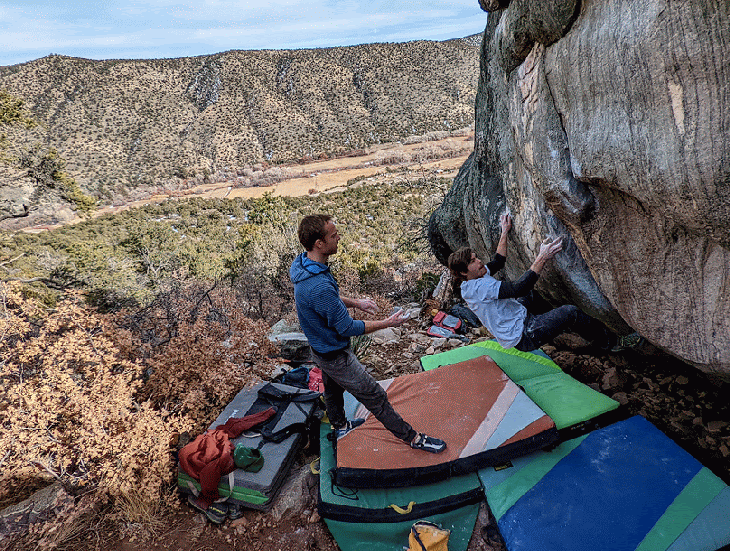
Buy the Veloce L on Backcountry.com
Part 1. Shape & Design
With its Veloce line (which also includes a z-strap slipper released in 2020), Scarpa has taken the comfortable-yet-performative mantra of earlier shoes like the Furia Air and ramped things up. The result sure is comfortable. The flexible microsuede upper gives the shoe’s interior a velvety feel; the softness allows the shoe to conform to your foot rather than the other way around; and the slight asymmetry gives you the performance benefits of an aggressive shoe* without feeling like you’re stressing the natural anatomy of your foot.
*Asymmetry (a) helps channel power from the foot to the big toe, and (b) makes it easier to curl your toes into edges on steep walls. For a more complete rundown of shoe shape and function, check out Part II of A Beginner’s Guide to Climbing Shoes.
The surprising benefits of a wide toe box
The thing I was most impressed by about the Veloce’s shape is what Scarpa calls its Relaxed Performance Fit (RPF): essentially, RPF shoes have a wider-than-typical toe box, which allows more room for the fourth and fifth toes.
The wide toe box has two chief benefits and one location-specific drawback. Benefit #1: It drastically enhances the comfort of the shoe, particularly for the wide-footed among us. The Veloce L saw me through numerous marathon gym sessions without pain, despite the fact that I sized way down (more on sizing below). I also wore it for extended hangdog sessions and while cleaning outdoor boulders on toprope. Benefit #2: It increases the toe box’s surface area, which makes the Veloce L surprisingly adequate on edges given that it’s also one of the softest shoes I’ve ever worn. The drawback? The Veloce L’s wide toe box makes it less than ideal for toeing into narrow pockets. If you’re heading to Margalef or Wild Iris you’ll want a pointier shoe.
Does rubber get better than this?
The first thing I noticed when I climbed in the Veloce L was that Scarpa’s S72 rubber may just be the stickiest stuff I’ve ever had on my feet. Combined with the shoe’s overall softness, the rubber made me feel a bit like a con artist, able to simply smear my feet where I wanted footholds to be and then proceed as if they actually existed. This was particularly true on volumes and in steeper outdoor areas with sloping feet. (I loved them, for instance, on the Maple-Canyon-esque cobbles of El Rito, New Mexico, and on the blocky basalt in Diablo Canyon, near Santa Fe.) The shoe also did very well on volcanic tuff, where I’ve found that stiffer shoes (Miuras, Sigmas, Quantix, etc.) feel insecure thanks to their inability to mold around the bubbly rock.
The only downside of the S72 rubber is that—as befitting a shoe designed primarily for indoor use—it does seem to wear relatively quickly when used outside, with the rubber almost pilling (see photo) after use on sharper edges. That said, I’ve used these shoes a lot in the past four months—easily 50 sessions—and they’re still in peak-performance mode.
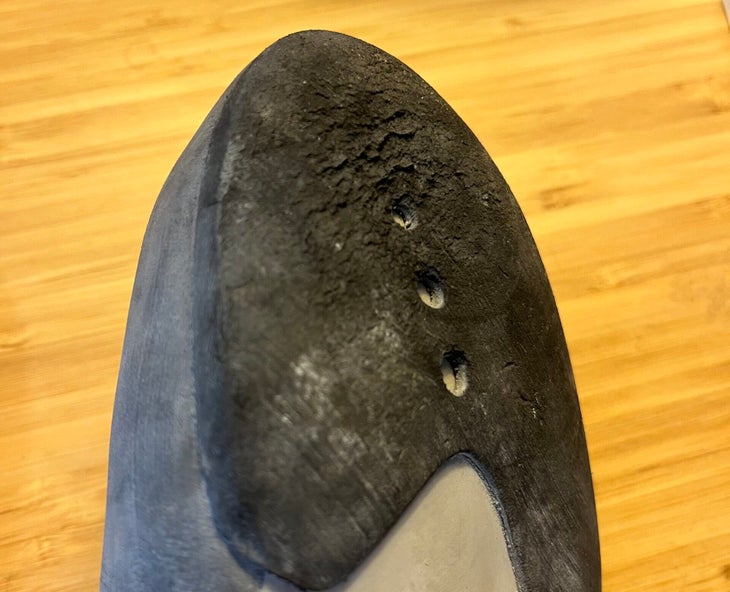
The versatility of a lace-up; the lightness (and toe-hooking abilities) of a slipper
Scarpa’s clever lace-up system gives the Veloce L the versatility and support of a lace-up while helping it avoid some of the major pitfalls associated with lace-up shoes: namely bulkiness and terrible toe hooking capabilities.
The Veloce L’s flat laces, offset lace pattern (which means that the laces track the shoe’s asymmetry rather than just forging up the middle), rubberized horizontal eyelets, and upper swath of M50 rand rubber make for a sleek and lightweight* closure system. Compared to many other lace ups (I’m looking at you, Testarossas) and velcro shoes (see: the Quantic and Quantix), the Veloce L feels like a slipper. But unlike a slipper, the lacing system makes the shoe super adaptable to different foot shapes and climbing scenarios. Got narrow feet? Cinch it down. Got wide feet? Loosen the toes and tighten the arch. Smearing on volumes or toeing into edges on steep walls? Tie your shoes loosely (or not at all) to maximize their flexibility. Need to stand on smaller edges? Crank the system tight.
*I should note that the Veloce L is a delightfully light shoe: at 6.9 ounces (for a size 40.5), they’re roughly 15 percent lighter than both the La Sportiva Futura and Scarpa’s bestselling Instinct VS, neither of which are known for their weight.
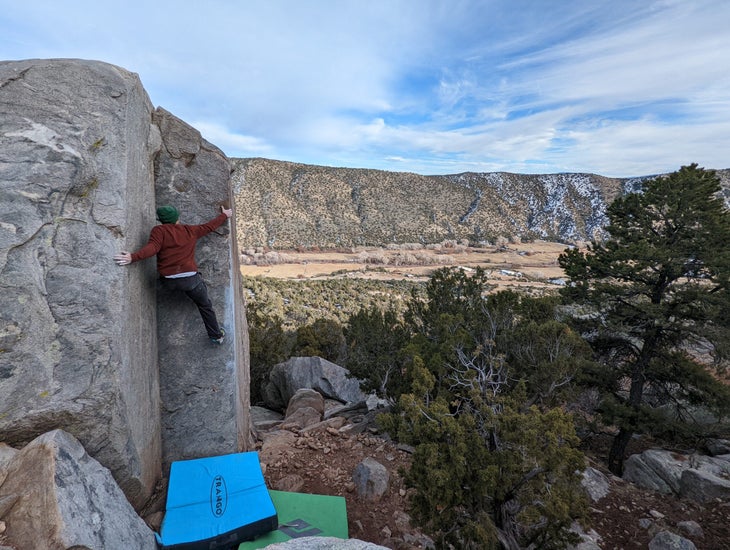
Part 2. Performance
Designed for indoor climbing, the shoe equally excels on volumes and sloping footholds as on boards and roofs. If you do the majority of your climbing inside, I can’t recommend this shoe enough. If you’re climbing outside a lot, you may want to supplement your quiver with a stiffer shoe, pairing it with something like a Quantix or a Miura VS.
Edging
The Veloce L is not supposed to be a strong edging shoe; it’s very soft, and it’s designed for gyms, where true edging is a rarity. But I found the shoe surprisingly adequate on edges, both indoor and out, which allowed me to use it as an all-arounder. Interestingly—blasphemy alert here—I found the shoes better at power-edging (my term for the sort of edging you do when standing tall off underclings with small edges for feet) than many shoes that are marketed for that exact task. Scarpa’s Mago, for instance, has a plastic insert in the toe to make it better at just such moves—but for me it fell short. The Veloce, meanwhile, isn’t supposed to be good at this sort of thing, but it performed quite well.
I credit the shoe’s adequate edging capability to three factors: (1) The slight asymmetrical last, 1mm Flexan midsole, ingenious DTS-Tension system, and well-designed lacing system together enhance the shoe’s midfoot support, channeling strength and power to your toes; (2) Scarpa’s RPF, which gives you more surface area to edge with; and (3) the M72 rubber, which sticks to just about everything and essentially allows you to smear comfortably on edges (i.e. smedge).
That said, it is NOT primarily an edging shoe, so if you’re planning on climbing in Smith Rock or Siurana or [insert heinous vert crag here], get something else. (In October last year, I took several trips to a blocky granitic crag in Northern New Mexico, where the style essentially involved driving powerfully down onto half-inch footholds. After smedging my way up an uncomfortable 5.11 warm up, I quickly traded the Veloce L for some more traditional edging shoes. (For that style I loved La Sportiva’s upgraded Miura VS [review here], Scarpa’s Quantix [review here], and Ocun’s Sigma [review here]—all of which are mildly down-turned and quite stiff.)
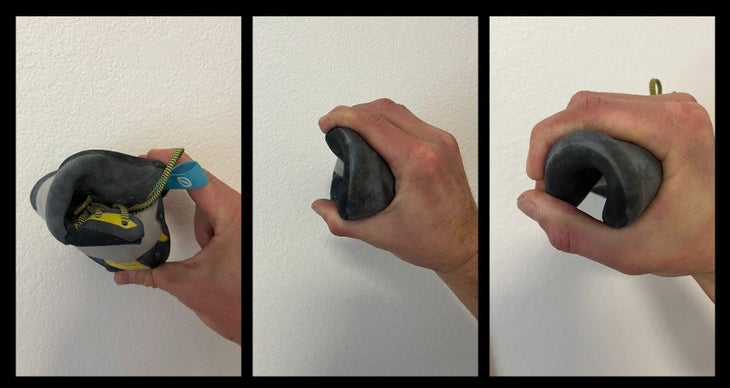
Toe hooking
Thanks again to the off-set laces, rubberized eyelets, super-sticky swath of M50 rand rubber, and the relative flexibility of the shoe, the Veloce L is one of the best lace-ups I’ve ever worn for toe hooking. I should note that I missed the memo on the La Sportiva Genius, which does look pretty solid in this regard. But the Veloce is lightyears ahead of the Miura, the Testarossa, and the Mago. The redpoint crux of a recent project of mine in northern New Mexico involved two consecutive toe hooks. Both felt sinker in the Veloce.
Heel hooking
While I generally find Scarpa’s heels a bit shallow, rising incompletely toward my achilles, I (a) acknowledge that this is probably a result of my choice of size (see below), and (b) am nonetheless quite impressed with the Veloce’s PAF heel, which is soft and very grippy and very sensitive. Once, however, while doing an inversion sequence that involved heel-hooking on a series of very sharp crimps in a roof, I ended up with bruising on the outside of my heel bone. Sensitivity comes with a price.
Part 3. Size and Fit
Fit-wise, the shoe is quite wide, and will be especially appealing to wider-footed climbers. As one reviewer said on Scarpa’s site, “[The Veloce L has a] much wider and higher volume last than the Drago or Furia, fitting much more like a more comfortable version of an Instinct VS.”
Definitely size this shoe down—or at least size it snugly. It’s incredibly comfortable and the microsuede upper stretches to your foot. I’m a snug US size 9.5 street shoe (I wear a 10 in some brands); I sized down to a U.S. 6.5. That’s probably a bit too much for people who aren’t troll-footed descendants of climbing’s tiny-shoe era. But even relative beginners should probably go down 1.5-2 sizes from their street shoe, advice that seems to align with the sizing preferred by other users of the shoe.
